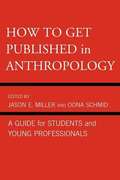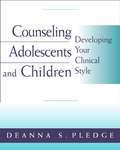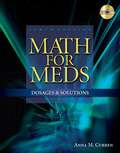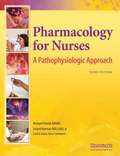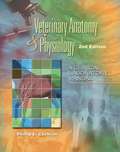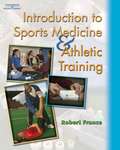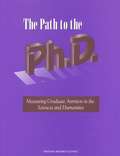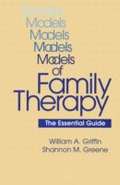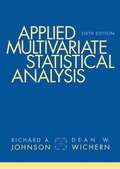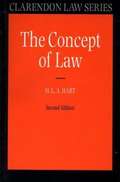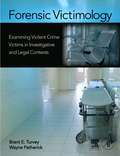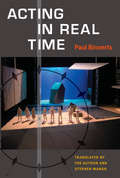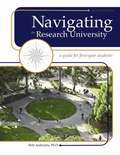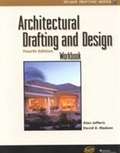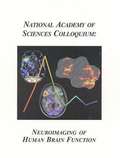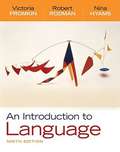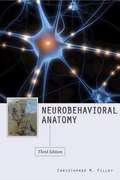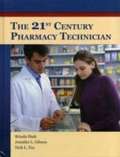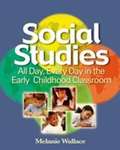- Table View
- List View
How to Get Published in Anthropology: A Guide for Students and Young Professionals
by Jason E. Miller Oona SchmidThis guide gives graduate students and young professionals the crucial information and tools they need to tackle the all-important requirement to publish. Part I provides guidance on key efforts including organizing a conference panel, creating a poster, presenting a paper, getting an article published, etc. In Part II, scholars offer first-hand insight into publishing in their area. Part III covers author contracts, copyright issues, collaboration, and online publishing opportunities.
Counseling Adolescents and Children: Developing Your Clinical Style
by Deanna S. PledgeThis book provides readers with an understanding of theoretical bases, the counseling process, specific problems and disorders, and the professional issues that surround the work of counseling children and adolescents. Its unique child-centered, family approach to counseling emphasizes the interaction and assistance of family members, which is critical in the counseling process. Within the discussion of empirical knowledge regarding various aspects of working with children, adolescents, and families, Pledge offers practical information that readers can readily apply to their work. Coverage of developmental phases, family considerations, and theoretical models provides readers with a solid foundation in the issues central to effective counseling with children and adolescents. This book addresses specific problems and disorders counselors commonly face when counseling children, including mood disorders, behavior disorders, developmental disorders, and normal developmental challenges.
Human Anatomy and Physiology (4th edition)
by Elaine N. MariebIn this text Marieb (Holyoke Community College) integrates the relationships of body organ systems, homeostasis, and complementarity of structure and function.
International Business
by Mason A. Carpenter Sanjyot P. DunungInternational Business is one of the most challenging and exciting courses to teach in the Business School. To teach a current, dynamic and complete course you need a textbook by authors as passionate and informed about International Business as you are. Carpenter and Dunung's International Business: The Opportunities and Challenges of a Flat World provides exploration into building, leading, and thriving in global organizations in an increasingly flat world. The authors define "Flat world" as one where (1) service industries that dwarf manufacturing industries in terms of scale and scope, (2) an Internet that pervades life and work, and (3) networks define modern businesses, whether service or manufacturing. Carpenter and Dunung's text is designed to speak to technologically-savvy students who see national borders as bridges and not barriers. The authors use the lexicon of international business, and additionally, develop students' knowledge of international contexts with the aim that they may launch, run, and work in any organization that is global in scope (or is wrestling with global competition or other global threats)
Information Systems: A Manager's Guide to Harnessing Technology version 1.3
by John GallaugherInformation Systems: A Manager's Guide to Harnessing Technology V 1.3 is intended for use in undergraduate and/or graduate courses in Management Information Systems and Information Technology. Version 1.3 of John's book retains the same structure and theory of version 1.1 and V 1.2, but refreshes key statistics, examples, and brings case material up to date (vital when covering firms that move as fast as Facebook, Google, and Netflix). For example; the Netflix chapter - Updates address the major changes impacting Netflix in 2011, including the response to the firm's pricing changes, the failed Qwikster service split, recent developments impacting the streaming and DVD-by-mail businesses, a comparison table detailing the stark differences between the firm's two offerings (DVD & streaming), updated statistics, learning objectives, and additional exercises and updates to the Google chapter - Updated text/images for currency, additional sub-sections on the firm's Google+ launch and the acquisition of Motorola Mobility. Adopting version 1.3 guarantees your students will have the most current text on the market, drawing real and applicable lessons from material that will keep your class offerings current and accessible.
Money and Banking v 2.0
by Robert E. WrightThe financial crisis of 2007-8 has already revolutionized institutions, markets, and regulation. Wright's Money and Banking V 2.0 captures those revolutionary changes and packages them in a way that engages undergraduates enrolled in Money and Banking and Financial Institutions and Markets courses. Minimal mathematics, accessible language, and a student-oriented tone ease readers into complex subjects like money, interest rates, banking, asymmetric information, financial crises and regulation, monetary policy, monetary theory, and other standard topics. Numerous short cases, called "Stop and Think" boxes, promote internalization over memorization. Exercise drills ensure basic skills competency where appropriate. Short, snappy sections that begin with a framing question enhance readability and encourage assignment completion. The 2.0 version of this text boasts substantive revisions (additions, deletions, rearrangements) of almost every chapter based on the suggestions of many Money and Banking instructors. Some specific highlights are: Chapter 11 now contains enhanced descriptions of recent regulatory changes, including Dodd-Frank, Chapter 12 is an entirely new chapter on derivatives covering forwards, futures, options, and swaps that also including comprehensive treatment of the causes and consequences of financial crises, and Chapter 14 has updated discussions of the Federal Reserve's monetary policy tools, including paying interest on reserves, and the structure and leadership of the European Central Bank. Recent financial turmoil has increased student interest in the financial system but simultaneously threatens to create false impressions and negative attitudes. This up-to-date text by a dynamic, young author encourages students to critique the financial system without rejecting its many positive attributes. Peruse the book online now to see for yourself if this book fits the needs of your course and students.
Math for Meds: Dosages and Solutions (10th Edition)
by Anna M. CurrenIncrease your confidence and aptitude in dosage calculations with the best-selling ratio and proportion book on the market! Learn from the master, Anna Curren, who has successfully taught dosage calculations to thousands of students. This new edition of Math for Meds includes full-color drug labels and syringes throughout, which are tied to questions that test your understanding and mastery of the concepts. With the goal of helping you become a safe and effective practitioner, Math for Meds walks you through basic and advanced calculations in detail, including intravenous and pediatric calculations.
Pharmacology for Nurses: A Pathophysiologic Approach (3rd Edition)
by Michael Patrick Adams Leland Norman Holland Jr. Carol Q. UrbanThe third edition of Pharmacology for Nurses: A Pathophysiologic Approach has been thoroughly updated to reflect current pharmacologic drugs and processes. This book is structured to present pharmacology and pathology together, so students can more easily grasp the interrelationship between these subjects and patient care.
Veterinary Anatomy and Physiology: A Clinical Laboratory Manual (2nd Edition)
by Phillip E CochranThis text is a laboratory manual for a detailed study of comparative veterinary anatomy and physiology. Useful for veterinary technology and pre-veterinary medicine students, it covers cat dissection, sheep heart, brain and eye, and the pig's kidney. Veterinary Anatomy & Physiology and also covers the muscular, digestive, respiratory, cardiovascular, urinary, reproductive, endocrine and nervous systems, as well as the skeletal anatomy of many species and the histology of tissues.
Introduction to Sports Medicine and Athletic Training
by Robert C. FranceIntroduction to Sports Medicine & Athletic Training is a book written for individuals interested in athletics and the medical needs of athletes. This book is unique in that it covers four distinct disciplines in an easy to understand format. The four disciplines covered include: Sports Medicine, Athletic Training, Anatomy, and Physiology. This all-in-one resource allows the individual to grasp the concepts of anatomy and physiology, and then apply them to Sports Medicine and Athletic Training. Each discipline is fully presented, and uniquely sequenced together to give the user a full understanding of this exciting field. There are comprehensive chapters on nutrition and sports psychology. Instructors will enjoy the depth of the material covered and the ease in which it is presented. Introduction to Sports Medicine & Athletic Training is the first full-concept book ever written that an entire course can be created around.
The Path to the Ph.D.: Measuring Graduate Attrition in the Sciences and Humanities
by National Research CouncilThere is a growing concern among educators and policymakers about the level of attrition from Ph.D. programs in the sciences and humanities at some U.S. universities. Reliable estimates of graduate student attrition are difficult to obtain, however, because most information comes from the administrative records of individual institutions.This book provides a summary of datasets that could be used to analyze patterns of graduate student attrition and degree completion nationally, along with an analysis of recent studies on the subject. Based on this information, the committee examines the feasibility of designing a system to produce national estimates of graduate student attrition.
The Medical Assistant: An Applied Learning Approach (9th Edition)
by Debora B. Kennedy Alexandra Patricia YoungThis leading, well-established textbook covers the administrative and clinical skills all medical assistants need to know, integrating all of the topics and skills competencies required by the AAMA entry-level Medical Assisting Curriculum. It features chapter outlines and learning objectives as well as relevant material dealing with personal qualities, skills, responsibilities, types of patient education, and legal and ethical issues. The unique Kinn approach - teaching essential skills alongside the medical specialty context - is the signature feature of this book. In addition, the 9th edition introduces a new "applied learning approach" that focuses on a real-world context for skills and requires the student to apply theory and skills to various case studies throughout the chapters.
Models of Family Therapy: The Essential Guide
by Williams A. Griffin Shannon M. GreeneModels of Family Therapy provides an overview of established family therapy models. All classification schemes of family therapy models must reduce ideological complexity, ignore overlap, and generalize for the purposes of category inclusion and exclusion. Nonetheless, orientation differences do exist and the authors make these differences clear by placing ideas and methods into categories. To facilitate learning how the dimensions of each model "fit" with other models, this book enhances comparability by using the same general outline in all chapters. In these outlines, the critical components of each model are broken down into a few core assumptions, terms, techniques, and methods. These critical components are summarized consistent with their description in the original publications. Some of these models include structural, strategic, behavioral, psychoeducational, and experiential therapy. Because of the style of presentation, this book can be useful as a primary text or supplement in a marriage and family therapy course. In addition, graduate students and professionals can benefit from this guidebook in order to prepare for any state or national examination on marriage and family therapy.
Applied Multivariate Statistical Analysis (6th Edition)
by Richard Arnold Johnson Dean W. WichernThis market leader offers a readable introduction to the statistical analysis of multivariate observations. Gives readers the knowledge necessary to make proper interpretations and select appropriate techniques for analyzing multivariate data. Starts with a formulation of the population models, delineates the corresponding sample results, and liberally illustrates everything with examples. Offers an abundance of examples and exercises based on real data. Appropriate for experimental scientists in a variety of disciplines.
The Concept of Law (2nd Edition)
by H. L. A. HartH L A Hart's The Concept of Law is the classic text for the study of jurisprudence and legal philosophy and is probably the most important work of legal philosophy written this century. This second edition is particularly valuable as it combines Hart's original text with a postscript, in which he responds to criticisms of his theory levelled by such notable scholars as Dworkin, Fuller and Finnis. Written by him but only discovered after his death, it has been ably edited by JosephRaz and Penelope Bulloch of Balliol College, Oxford.
Forensic Victimology: Examining Violent Crime Victims in Investigative and Legal Contexts
by Brent E. Turvey Wayne PetherickThis new textbook provides students with the basic principles and practice standards of forensic victimology -the scientific study of victims for the purposes of addressing investigative and forensic issues. It provides case-based coverage with original insights into the role that victimology plays in the justice system, moving beyond the traditional theoretical approaches already available. The purpose of this textbook is to distinguish the investigative and forensic aspects of victim study as a necessary adjunct to the field of victimology. It identifies forensic victimologists in the investigative and forensic communities and provides them with methods and standards of practice needed to be of service. This book is intended to educate students on the means and rationale for performing victimological assessments with a scientific mindset. Forensic Victimology is designed specifically for teaching the practical aspects of this topic, with "hands on" real-life case examples and an extensive online Instructor's manual featuring summaries, key terms, and test questions for every chapter. * Applied victimology for students and caseworkers performing objective examinations as opposed to theoretical victimology that studies victim groups and crime statistics. * First ever textbook detailing a mandate, scope and methods for forensic victimologist practitioners. * Provides a critical / scientific counterbalance to existing mainstream texts approaching general victimology with a pro-victim bias. * Written by practitioners of forensic victimology in the investigative, forensic, mental health, and academic communities.
Acting in Real Time
by Paul BinnertsActing in Real Time by renowned Dutch director and acting teacher Paul Binnerts describes his method for Real-Time Theater, which authorizes actors to actively determine how a story is told---they are no longer mere vehicles for delivering the playwright's message or the director's interpretations of the text. This level of involvement allows actors to deepen their grasp of the material and amplify their stage presence, resulting in more engaged and nuanced performances. The method offers a postmodern challenge to Stanislavski and Brecht, whose theories of stage realism dominated the twentieth century. In providing a new way to consider the actor's presence on stage, Binnerts advocates breaking down the "fourth wall" that separates audiences and actors and has been a central tenet of acting theories associated with realism. In real-time theater, actors forgo attempts to become characters and instead understand their function to be storytellers who are fully present on stage and may engage the audience and their fellow actors directly. Paul Binnerts analyzes the ascendance of realism as the dominant theater and acting convention and how its methods can hinder the creation of a more original, imaginative theater. His description of the techniques of real-time theater is illuminated by practical examples from his long experience in the stage. The book then offers innovative exercises that provide training in the real-time technique, including physical exercises that help the actor become truly present in performance. Acting in Real Time also includes a broad overview of the history of acting and realism's relationship to the history of theater architecture, offering real-time theater as an alternative. The book will appeal to actors and acting students, directors, stage designers, costume designers, lighting designers, theater historians, and dramaturgs.
Navigating the Research University: A Guide for First-year Students (2nd Edition)
by Britt AndreattaFull of practical tips and tools, and useful personal advice, Navigating The Research University: A Guide For First-Year Students, Second Edition, provides first-year students with a comprehensive introduction to education at a research institution. The text is designed to support students at a broad range of research universities by helping them understand what research is, the role it plays in the university, and the basic methodologies used in a variety of disciplines. Andreatta guides students to develop essential skills for academic success, including critical thinking, thoughtful analysis, and effective writing. In addition, the text includes valuable insights into the personal and working issues students may encounter as new and aspiring members of a community of scholars.
Architectural Drafting and Design Workbook (4th Edition)
by Alan Jefferis David A. MadsenThis stellar new edition details step-by-step methods for the design and layout of each type of drawing required for a complete set of architectural plans. This comprehensive handbook also contains a copy of the AutoCAD 2000 direct-to-student software and dwg files of selected plans in the book, supplemented by expanded coverage of CADD and freehand sketching techniques. Readers are challenged to think through and solve numerous design problems while adhering to the latest Universal Building Code, CABO and SBCCI codes; meeting requirements of the Americans with Disabilities Act; taking into account the latest NDS wood design standards; and considering the growing popularity of engineered lumber and steel construction.
Colloquium On Neuroimaging Of Human Brain Function
by Frank Rosler Charan Ranganath Brigitte Roder Rainer KluweThe National Academies Press (NAP)--publisher for the National Academies--publishes more than 200 books a year offering the most authoritative views, definitive information, and groundbreaking recommendations on a wide range of topics in science, engineering, and health. Our books are unique in that they are authored by the nation's leading experts in every scientific field.
An Introduction to Language (9th Edition)
by Victoria Fromkin Robert Rodman Nina HyamsAssuming no prior knowledge of linguistics, AN INTRODUCTION TO LANGUAGE, Ninth Edition, is appropriate for a variety of fields--including education, languages, psychology, anthropology, English, and teaching English as a Second Language (TESL)--at both the undergraduate and graduate levels. This completely updated edition retains the clear descriptions, humor, and seamless pedagogy that have made the text a perennial best-seller, while adding new information and exercises that render each topic fresh, engaging, and current.
Neurobehavioral Anatomy, Third Edition
by Christopher M. FilleyThoroughly revised and updated to reflect key advances in behavioral neurology, Neurobehavioral Anatomy, Third Edition is a clinically based account of the neuroanatomy of human behavior centered on a consideration of behavioral dysfunction caused by disorders of the brain. A concise introduction to brain-behavior relationships that enhances patient care and assists medical students, the book also serves as a handy reference to researchers, neuroscientists, psychiatrists, and geriatricians. The book outlines how cognitive and emotional functions are represented and organized in the brain to produce the behaviors regarded as uniquely human. It reviews the effects of focal and diffuse brain lesions, and from this analysis a conception of the normal operations of the healthy brain emerges. Christopher M. Filley integrates data and material from different disciplines to create a concise and accessible synthesis that informs the clinical understanding of brain-behavior relationships. Clinically practical and theoretically stimulating, the book is an invaluable resource for those involved in the clinical care and study of people with neurobehavioral disorders. Including a useful glossary and extensive references guiding users to further research, the third edition will be of significance to medical students, residents, fellows, practicing physicians, and the general reader interested in neurology.
The 21st Century Pharmacy Technician
by Nick L. Tex Jennifer L. Gibson Brinda ShahThe 21st Century Pharmacy Technician covers the foundations and principles that a student needs to know in order to practice as a pharmacy technician and sit for the certification exam. Students are given an introduction to the profession from the perspective of both community and institutional pharmacy settings. With accessible language and an easy-to-read format, this text helps students grasp concepts easily. It provides a comprehensive introduction to the pharmacy profession, pharmacy laws, pharmacology, drug dosages, drug safety, and more, in preparation for a future as a pharmacy technician. Topics covered include:#149; Laws, Regulations, and Standards#149; Pharmacy Math#149; Diseases and the Drugs Used in Treatment#149; Dosage, Administration, and Dispensing of Medications#149; Medication Safety#149; Sterile and Non-sterile Compounding#149; Communication#149; Business of the Community Pharmacy#149; Managing the Patient Profile#149; Processing Prescriptions
Social Studies: All Day, Every Day in the Early Childhood Classroom
by Melanie WallaceSocial Studies - All Day, Every Day, is a research based text containing the latest research on learning styles, reading and math, and best practices. In light of the recent No Child Left Behind legislation, many teachers of young children are opting out of teaching social studies in favor of spending more time on reading and math instruction. Not only is this inappropriate and unfair to the students, it is unnecessary. In this text, the reader will discover ways to study in-depth, a wide range of the social studies, while spending the necessary time and intellectual energy developing reading and mathematical skills. The opening chapters of the text define the social studies and describe the National Council of Social Studies (NCSS) standards as they relate to teaching young children. The remainder of the text breaks down teaching methodology for working with young children and the social studies, and looking at individual disciplines within the social studies. Practical application, with a theoretical base, is the key to this text.
An Introduction to Category Theory
by H. SimmonsCategory theory provides a general conceptual framework that has proved fruitful in subjects as diverse as geometry, topology, theoretical computer science and foundational mathematics. Here is a friendly, easy-to-read textbook that explains the fundamentals at a level suitable for newcomers to the subject. Beginning postgraduate mathematicians will find this book an excellent introduction to all of the basics of category theory. It gives the basic definitions; goes through the various associated gadgetry, such as functors, natural transformations, limits and colimits; and then explains adjunctions. The material is slowly developed using many examples and illustrations to illuminate the concepts explained. Over 200 exercises, with solutions available online, help the reader to access the subject and make the book ideal for self-study. It can also be used as a recommended text for a taught introductory course.
